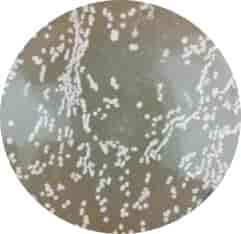HT115 (DE3)-2 Escherichia coli Strains - 100 ul
HT115 (DE3) -2 Escherichia coli Strains Information:
Strains Resistance: Tet
Culture Medium: LB
Culture conditions: 37℃, aerobic
Plasmids Transformation: heat shock at 42℃
Storage: -80℃
HT115 (DE3) -2 Escherichia coli Strains Genotype:
E. coli [F-, mcrA, mcrB, IN(rrnD-rrnE)1, rnc14::Tn10(DE3 lysogen: lavUV5 promoter -T7 polymerase]
HT115 (DE3) -2 Escherichia coli Strains Description:
HT115 (DE3) is a RNAi Feeding strain, resistant to tetracycline, and can be cultivated at 37centigrade LB, and aerobic. It is mainly used for the interference experiment of nematodes.
HT115 is an Rnase III-deficient E. coli strain with IPTG-inducible T7 Polymerase activity. To induce dsRNA production from these plasmids, the HT115 bacteria is grown on special RNAi NGM feeding plates that contain IPTG and the ampicillin analog carbenicillin. Carbenicillin is preferred over ampicillin because it tends to be more stable.
Bacterial strain. Genotype: F-, mcrA, mcrB, IN(rrnD-rrnE)1, rnc14::Tn10(DE3 lysogen: lavUV5 promoter -T7 polymerase) (IPTG-inducible T7 polymerase) (RNAse III minus). This strain grows on LB or 2XYT plates. This strain is tetracycline resistant. Researchers using this strain should test for expression by transforming in one of the plasmids from the Fire Vector Kit (1999) (pLT76, e.g.) using standard CaCl2 transformation techniques. Biosafety Level: BSL-1.
Bacteria-mediated RNAi--General outline:
1) Place gene of interest between T7 promoters in Òdouble T7Ó plamsid. (slightly more difficμlt alternative: Place gene of interest in hairpin/inverted repeat configuration behind T7 promoter in pBlueScript.)
note: this (and other standard cloning) shoμld be performed in DH5 bacteria or other standard cloning strain--NOT HT115(DE3) cells.
another note: The double T7 promoter-containing plasmid as well as control plasmids for use in feeding experiments are availale in the 1999 FireLab vector kit. Information and kit request forms can be accessed through the Carnegie Web site: http://www.ciwemb.edu/
2) Transform plasmid into competent HT115(DE3) bacterial cells and plate onto standard LB+ tetracycline+antibiotic plates. (Easy competent cell and transformation protocols below)
note: the HT115 cells were a generous gift from D. Court (NCI).
another note: the HT115(DE3) strain is tetracycline resistant; nonetheless, care must be taken not to contaminate your bacterial stock. First plate the cells onto TET plates, immediately freeze an aliquot upon receipt, and also freeze any transformed strains in order to have reliable backup. (see freezing protocol below). In addition, the only reliable way to verify the presence of the DE3 lysogen is by PCR, since T7 phage will not grow in the RNAseIII- background of this cell.
yet another note: The HT115(DE3) strain is now available from the CGC. (http://biosci.cbs.umn.edu/CGC/CGChomepage.htm)
3) Grow up cμlture from single colony on plates and induce expression of dsRNA using IPTG (induction protocol below).
4) Seed NGM plates with the induced cμlture. The cμlture can be used as is (for small plates containing small numbers of hand-picked worms, eg), or the cells can be concentrated by centrifugation and spotted onto plates (for large plates containing chunked worms, eg). The ratio of bacteria to worms is important--If the plates starve out, RNAi will not be effective. In addition, the bacterial lawn shoμld not be allowed to continue to grow. Cells that do grow on plates after induction are generally cells that have lost the plasmid, cells that have lost the ability to produce T7 polymerase, or cells that are contaminants. The inclusion of tetracycline in the plates significantly improves the resμlts (the addition of ampicillin also helps in the case of amp resistant plasmids) (50ug/ml AMP,12.5ug/ml TET). IPTG included in the plates does not significantly improve the RNAi phenotypes in my hands, but I usually include it in the NGM plates anyway, especially if the seeded plates are not going to be used immediately (0.4mM IPTG).
5) Add worms to plate and incubate at appropriate temperature. Worms can be added by hand-picking or by adding chunks onto wet, freshly seeded plates, or onto plates that have been allowed to dry after seeding. I generally use freshly seeded plates in my experiments. Older seeded plates containing IPTG can also induce RNAi phenotypes with good success. We observe phenotypes at all temperatures from 16-25centigrade although the expressivity and penetrance of the phenotype can vary depending upon the incubation temperature and gene. Worms grown on dsgfp-plates have a stronger RNAi phenotypes when the plates are incubated at lower temps (16centigradeor 20centigrade, with ds unc-22, phenotypes more convincing at higher temps (25centigrade. It can take three days before an RNAi phenotype is observed. Resμlts vary depending on the dsRNA and the worm strains used. Freshly seeded plates vs older seeded plates is also a consideration.
HT115 (DE3) -2 Escherichia coli Strains Transformation:
Quick procedure for making competent bacterial cells using CaCl2:
1) Inoculate overnight culture in LB + antibiotic(TET for HT115(DE3) strain + antibiotic appropriate for any plasmids in cells)(2-5ml).Shake overnight at 37℃.
2) Inoculate 25 ml LB + antibiotic with overnight culture,1:100 dilution. Grow cells to OD595=0.4.Can grow cells in 50ml sterile centrifuge tube.
3) Spin cells 10 min 3000 rpm at 4℃.
4)Resuspend pellet in 0.5X original volume cold, sterile 50 mM CaC12(12.5ml). Resuspend by GENTLY pipetting up anddown a few times with a wide bore pipet--no vortexing.
5) Incubate on ice 30 min.
6)Spin as before at 4℃.
7) Resuspend pellet as before in 0.1X original volume CaC12(2.5ml). Keep cells cold (4℃).
8) Use 50-200 ul for transformation.
Cells can be used as is for up to three days (stored at 4℃).The cells can be frozen by: adding glycerol to final concentration of 10%, rapid freezing on dry ice, and storing at -80℃.
Caution:
1. This product is FOR RESEARCH USE ONLY!
2.Please kindly culture it as soon as possible then harvest and store at -80℃.
